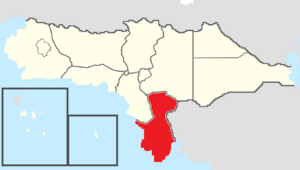San Andreas
This article is incomplete because it is pending further input from participants, or it is a work-in-progress by one author. Please comment on this article's talk page to share your input, comments and questions. Note: To contribute to this article, you may need to seek help from the author(s) of this page. |
State of San Andreas | |
|---|---|
State | |
| Nickname: The Golden State (official) | |
| Motto: | |
 Map of Rizealand with San Andreas in red | |
| Country | |
| Before Statehood | Republic of San Andreas |
| Capital | Fremont |
| Largest city | Los Santos |
| Joined Federation | September 9, 1855 (6th) |
| Government | |
| • Governor | Emanuel Rodriguez (NPC-ND) |
| • Deputy Governor | Caleb Harris (NPC-ND) |
| • Legislature | San Andreas State Assembly |
| • Federal representation | Councilors
|
| Area | |
| • Total | 170,390.68 km2 (65,788.21 sq mi) |
| Population (2021) | |
| • Total | 9,373,100 |
| • Density | 55/km2 (140/sq mi) |
| Time zone | UTC+10 (Central) |
| Abbreviation | SA |
| ISO 3166 code | RZ-SA |
| Website | www |
San Andreas, known officially as the State of San Andreas and unofficially as "SA" or "San An", is a state in southern Rizealand that is bordered by Lyhoming to the north, Marchenia to the east, the Vehemens Ocean to the south and southwest, and Fáel to the northwest. San Andreas has a total area of 170,390.68 square kilometers, making it the fifth largest state and political division of Rizealand. San Andreas also has a population of 9,373,100, making it the third most populous state and political entity in Rizealand. San Andreas's capital is Fremont and its largest city is Los Santos. It is also home to several other large coastal cities including Las Venturas, Huffington Beach, and Irving.
Etymology
The "State of San Andreas" derives its name from the Republic of San Andreas, which was annexed by Rizealand and granted statehood. The Republic of San Andreas was named after the San Andreas Mountains in central San Andreas. The name "San Andreas" is Esmeiran for Saint Andrew, a Sotirian saint and apostle.
Geography
Ecology
Climate
Conservation
Demographics
Population
Language
Religion
Health
Education
Urban Areas
Government and politics
The government of San Andreas is established and organized according to the Constitution of San Andreas. Because San Andreas is a constituent state of Rizealand, the powers of its government are subject to certain limits by the Articles of Federation including the requirement of a democratic form of government and prohibitions on forming alliances with foreign governments, declaring war, raising or maintaining armies, establishing forms of currency, and placing unlawful restraints on interstate and international trade. In addition to constitutional restraints on state power, the Articles also allow the Central Assembly to enact legislation that can supersede state laws when involving national security, interstate commerce, foreign affairs, immigration, and the public's welfare. Like the federal government of Rizealand, the government of San Andreas is divided into three branches of government.
The legislative branch consists of a unicameral State Assembly. The State Assembly's 120 seats are filled through closed party list proportional representation elections held every five years. As the state legislature, the State Assembly is responsible for enacting legislation and can do so with a simple majority, although a majority of two-thirds is required to override the Governor's veto, enact super laws, or remove government officials from office. The State Assembly is also responsible for approving the Governor's executive and judicial nominations.
The executive branch is headed by the following constitutional officers elected in statewide two-round direct elections at the same time as the State Assembly for five-year terms with a two term limit.
- The Governor is the head of state and government responsible for signing legislation into law, nominating executive agency heads and judges, and enforcing the laws of the state.
- The Deputy Governor assists the Governor in carrying out his duties and becomes governor if the office falls vacant.
- The Secretary of State is responsible for maintaining state records, handling corporation filings, and serving as chair of the Election Commission of San Andreas
- The State Treasurer is responsible for serving as the state's chief financial officer by handling state finances, investments, and debt management, as well as conducting audits and accounting for state monies
- The Public Education Commissioner is responsible for overseeing public education systems in San Andreas and distributing state education funding
- The Public Safety Commissioner is responsible for the oversight of state and local law enforcement agencies
- The Attorney General is responsible for overseeing all criminal prosecutions, providing legal advice to the state government, issuing official opinions, and representing the state in court proceedings
The judicial branch consists of the High Court, courts of appeal, and superior courts. Justices and judges of San Andreas courts are nominated by the Governor and appointed by the State Assembly for a lifetime term subject to retention elections every five years.
There are also independent agencies and commissions established by the state constitution or state super laws that do not neatly fit into any branch of government, as they often enforce state laws (executive), issue rules and regulations (legislative), and adjudicate cases or claims (judicial). While their agency heads or commission members are usually nominated or appointed by the Governor, they can only be removed from office through impeachment and removal by the State Assembly.
San Andreas has a common law legal system with some Estmerish influences. In addition to the protections of the Articles of Federation, the San Andreas Constitution also establishes additional protections and gives citizens the right to recall state officials, refer legislation to a referendum vote, enact legislation via an initiative vote, and approve amendments to the state constitution.




